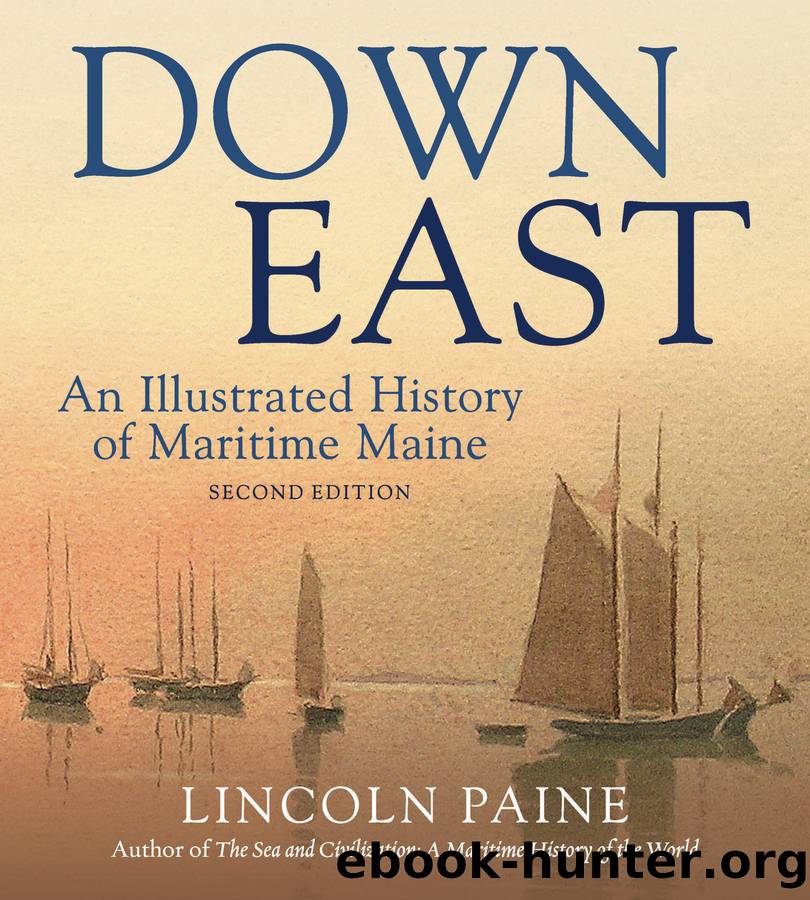Down East by Lincoln Paine

Author:Lincoln Paine
Language: eng
Format: epub
Publisher: Down East Books
Published: 2018-05-30T00:00:00+00:00
A two-masted gaff-rigged canal boat on Sebago Lake. Mounted on deck in tabernacles, the masts could be lowered quickly when passing under bridges.
Courtesy the Maine Historical Society
The first steamer in commercial service in Maine was the Boston-built Tom Thumb, which was towed in 1818 or 1819 by a sailing packet to the mouth of the Kennebec, from where it proceeded upriver to Bath under its own power. Only 30 feet long, she was employed chiefly as an excursion vessel for six years. She then entered service on Passamaquoddy Bay and the St. Croix River between Eastport, St. Andrews (in New Brunswick), and Calais. By 1827 the Tom Thumb was back in southern Maine, seeing service first on the Kennebunk River before Charles W. Childs acquired her for work on the Piscataqua between Portsmouth and Dover, New Hampshire. In 1836, Childs accepted a contract to freight a two-ton iron tank to the lighthouse station on Boon Island. Contrary weather made it impossible for her to return to the Piscataqua, and she stranded on the island, though all her crew survived.
In the meantime, in 1822, a local entrepreneur named Seward Porter fitted a scow with paddle-wheels and an engine for service on the Kennebec (for which he named his steamer) between Hallowell and Waterville. Too underpowered to move against the current, the Kennebecâs schedule had to be changed daily to gain a favorable tide, and she was soon sold to Portland interests for work as an excursion steamer among the islands of Casco Bay. The following year, Porterâs Kennebec Steam Navigation Companyâthe stateâs first incorporated steamboat operatorâordered a purpose-built steamer called the Waterville (87 tons, 82 feet) from William Kingâs yard in Bath (where the United States Custom House now stands) for service between Bath and Augusta.
Early steamboats were plagued by explosions and fires, and Porter took advantage of one such disaster to start a long-distance steamer service at a relatively low cost. In the summer of 1823, five men were killed when an engine on the Hudson River steamer Patent exploded during trials. The bad publicity forced her owners to sell the Patent at a discount, and Porter ran her between Boston, Portland, and Bath, where passengers could connect to the Waterville. This enabled his company to offer weekly roundtrip service between Augusta and Boston, thus inaugurating more than a century of passenger steamboat service between the capitals of Maine and Massachusetts. The next year, the sternwheel-driven âcatamaranâ steamer Maineâprobably two schooner hulls lashed together in some configurationâbrought weekly service from Bath to Bangor via Boothbay, Waldoboro, Owlâs Head, Camden, Belfast, Castine, and Bucksport. Routes changed frequently as operators sought to obtain the best rates possible, and by 1825 the Maine was sailing between Portland and Eastport, with connecting service at Bath and Eastport.
As the name of Porterâs first steamer suggests, people had long had their sights set on running steamboats on the Kennebec at least as far upriver as Waterville. This dream was finally realized in 1832, when a 99-ton
Download
This site does not store any files on its server. We only index and link to content provided by other sites. Please contact the content providers to delete copyright contents if any and email us, we'll remove relevant links or contents immediately.
| Civilization & Culture | Expeditions & Discoveries |
| Jewish | Maritime History & Piracy |
| Religious | Slavery & Emancipation |
| Women in History |
Cecilia; Or, Memoirs of an Heiress — Volume 1 by Fanny Burney(32439)
Cecilia; Or, Memoirs of an Heiress — Volume 2 by Fanny Burney(31875)
Cecilia; Or, Memoirs of an Heiress — Volume 3 by Fanny Burney(31858)
The Secret History by Donna Tartt(18859)
Sapiens: A Brief History of Humankind by Yuval Noah Harari(14257)
Leonardo da Vinci by Walter Isaacson(13189)
The Radium Girls by Kate Moore(11930)
Sapiens by Yuval Noah Harari(5295)
How Democracies Die by Steven Levitsky & Daniel Ziblatt(5133)
The Wind in My Hair by Masih Alinejad(5034)
Homo Deus: A Brief History of Tomorrow by Yuval Noah Harari(4827)
Endurance: Shackleton's Incredible Voyage by Alfred Lansing(4683)
The Silk Roads by Peter Frankopan(4460)
Man's Search for Meaning by Viktor Frankl(4435)
Millionaire: The Philanderer, Gambler, and Duelist Who Invented Modern Finance by Janet Gleeson(4386)
The Rape of Nanking by Iris Chang(4140)
Joan of Arc by Mary Gordon(4021)
The Motorcycle Diaries by Ernesto Che Guevara(4018)
Hitler in Los Angeles by Steven J. Ross(3902)
